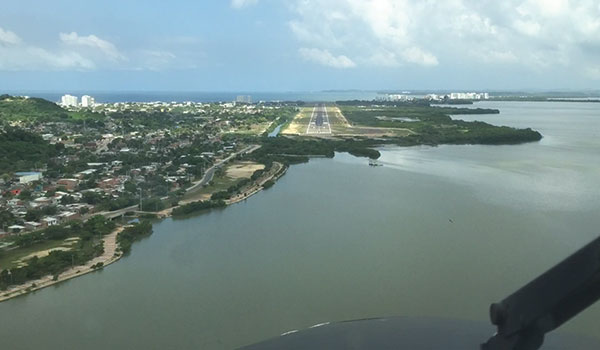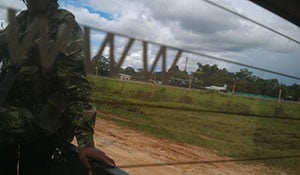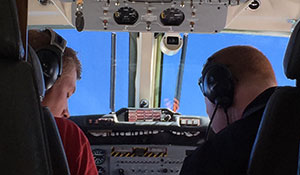
Army National Guard Aviation / By COL Mark Weiss and COL (Ret.) Kevin Scherrer: A recent case study of an air traffic controller who developed type II (neurologic) decompression sickness (DCS) after a series of four consecutive training SCUBA dives illustrates the dangers of DCS for military and civilian divers and aviators.

On final approach into El Dorado International Airport, Bogata, Colombia. / ALL PHOTOS COURTESY U.S. ARMY NATIONAL GUARD
Despite the end of IRAQI FREEDOM and ENDURING FREEDOM, your Army National Guard force is still engaged in the Away Game, and contributing on multiple fronts. Most visible is our current presence in Kuwait. Without getting into specifics, suffice it to say that we’ve got almost a brigade’s worth of aircraft and people there, prepared to respond anywhere in the Central Command (CENTCOM) Area of Responsibility (AOR). We’re also still in Kosovo, providing a battalion headquarters and flying company to support peacekeeping missions there. But we also have smaller, shorter-duration missions sprinkled throughout the world – missions not so well-known – that represent our ability to mobilize, deploy, and conduct aviation missions globally.
As the former commander of the Operational Support Airlift Agency (OSAA), I refuse to agree with the notion that “fixed wing operations are not a core Army competency.” But core or otherwise, our airplane operations are important at home and abroad. Missions such as ODIN (Observe, Detect, Identify, Neutralize) in Afghanistan and Iraq have saved Soldier lives. Missions such as delivering post-hurricane supplies and response teams have saved citizen lives. And missions such as the one I’m about to describe… they indirectly do both.
Small But Impactful
Our ARNG OSAA, through its “OSACOM” command, is currently supporting the U.S. Embassy in Colombia with a small fixed wing capability. Based out of Bogota, our single-ship detachment of one C-12, one NCO, and three crewmembers serves in a Title 10 Status for deployments of short duration.
Our NCO, the Military Group Airlift Coordinator, works inside the Embassy and is the focal point for all mission coordination. He (or she) receives all air mission requests, filters them, forwards them to U.S. Southern Command (SOUTHCOM) J-3 for approval, processes them through OSACOM Quality Assurance to ensure compliance with statutes and regulations, and passes them on to the 3-man aircrew for execution. The NCO deploys for a six to nine month rotation, while the crewmembers rotate out every 45 days. The mission has been on-going for about eight years, and shows no sign of dissipating in the near future.
 Landing at a remote location in Bogata, Colombia during a support mission.Daily missions are flown throughout the geographic region of Colombia and serve a variety of customers. In gross approximations, 40% of the missions are VIP transport, 40% are non-VIP personnel transport, and 20% are cargo missions (yes, we pull the seats out of the C-12 and turn it into a Chinook with fixed wings; in November-December 2014 alone, the single C-12 hauled over 10,000 pounds of cargo). While most missions involve Embassy passengers, the detachment often serves U.S. military forces and other U.S. Government agencies in support of classified operations. Less frequently, the crew flies humanitarian missions to help the Colombian population, such as delivering engineers and construction experts, to assist in local road and school construction projects.
Landing at a remote location in Bogata, Colombia during a support mission.Daily missions are flown throughout the geographic region of Colombia and serve a variety of customers. In gross approximations, 40% of the missions are VIP transport, 40% are non-VIP personnel transport, and 20% are cargo missions (yes, we pull the seats out of the C-12 and turn it into a Chinook with fixed wings; in November-December 2014 alone, the single C-12 hauled over 10,000 pounds of cargo). While most missions involve Embassy passengers, the detachment often serves U.S. military forces and other U.S. Government agencies in support of classified operations. Less frequently, the crew flies humanitarian missions to help the Colombian population, such as delivering engineers and construction experts, to assist in local road and school construction projects.
Criminal/Terrorist Threat
Make no mistake about it though, while Colombia has made incredible strides in combating criminal elements and reducing its illegal drug trade, there are still parts of the country that are controlled by the FARC – the Fuerzas Armadas Revolucionarias de Colombia–Ejército del Pueblo (in English: The Revolutionary Armed Forces of Colombia–People’s Army). The FARC is a guerilla insurgent organization which has been battling the host government since 1964. Using a variety of military and criminal tactics, the FARC claims to be an army of peasant Marxist–Leninists with a political platform of agrarianism and anti-imperialism. It is funded by kidnappings, illegal extortion and/or taxation, and the production and distribution of illegal drugs.
 US National Guard pilots prepare their C-12 for departure on a Columbian support mission.Environmental Challenges
US National Guard pilots prepare their C-12 for departure on a Columbian support mission.Environmental Challenges
Aside from the criminal/terrorist threat, there are other environmental challenges the aircrews must overcome. English is a second language to all of the air traffic controllers, and their proficiency is inconsistent. Bogata sits at 8,360 feet above sea level, and is surrounded by 12,000 peaks, demanding every bit of performance from the C-12 and crew. Airport operations are only marginally controlled (visualize “cows on the runway”). Notices to Airmen (NOTAMs) are relatively non-existent. So for each mission, regardless of its destination, our aircrews perform the necessary composite risk management to ensure safe mission accomplishment. And our record speaks for itself – in eight years of operation, this detachment has had zero aviation mishaps.
The professionalism of these OSAA soldiers is exemplified by SFC Jaime Fuentes. Now based out of the Regional Flight Center at Fort Hood, Texas (Gray Army Airfield), SFC Fuentes just returned from a seven-month deployment in support of this mission. This fifteen-year Soldier served as the Military Group Airlift Coordinator, and as such, had daily contact with State Department, Congressional, and military leadership, and – as they say on our award citations – brought great credit to OSAA, Army Aviation, and the Army National Guard.
So, the next time you’re overseas and spot an Army helicopter or C-12, look closer – it might just be from your Army National Guard.
Fly Safe, fly Guard.
COL Mark Weiss is the Chief of the Aviation and Safety Division for the Army National Guard Directorate, in Arlington, VA. COL (Retired) Kevin Scherrer is a support contractor with System Studies and Simulation, Inc.








